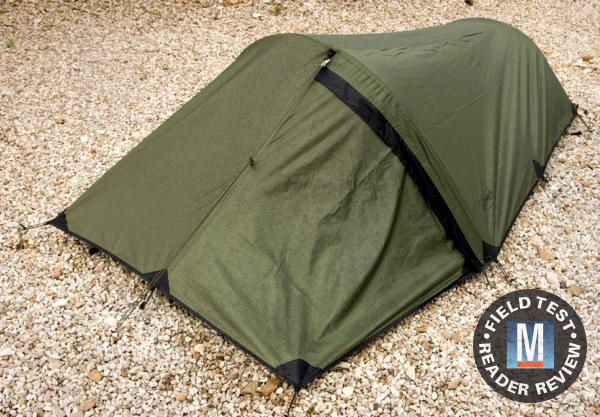 Snugpak's IONOSPHERE is an inexpensive, military-style bivy that features a mesh inner shelter to keep the bugs out and a rainfly to keep you dry. I spent enough time in it to get a feel for its set-up and break-down times, weather tolerance, packability, concealability, weight and comfort.
Snugpak's IONOSPHERE is an inexpensive, military-style bivy that features a mesh inner shelter to keep the bugs out and a rainfly to keep you dry. I spent enough time in it to get a feel for its set-up and break-down times, weather tolerance, packability, concealability, weight and comfort.
Snugpak has a reputation for making high-quality gear and the IONOSPHERE follows that tradition. But it has shortcomings that make it ill-suited for life outside the wire.
PACKING THE IONOSPHERE: Before I left with my kit and ruck, I tried to figure a way to rig the IONOSPHERE for carrying on the outside of my ruck. I had room to put it in my ruck but, I was afraid the tent poles may be damaged during my movement. I had to place it on top, under the main ruck synch straps and tighten them down. The 14-inch x 5-inch bundle wasn’t really secure, but it did the job for the moment.
outside of my ruck. I had room to put it in my ruck but, I was afraid the tent poles may be damaged during my movement. I had to place it on top, under the main ruck synch straps and tighten them down. The 14-inch x 5-inch bundle wasn’t really secure, but it did the job for the moment.
There really isn’t an easy way to stow this piece of equipment on an ALICE pack, especially a heavy one. The con is carrying it on or in the ruck. There just isn’t a good or convenient way to do so. On the pro side, its light weight allows it to be stowed on the outside with little to no hindrance of the wearer. The solution I see is if the stuff sack had universal or compatible buckles to attach this piece of equipment easily to an assault pack or a rucksack.
WEIGHT: This bivy weighs 3.4 pounds packed up. Not bad, but I'd rather take my poncho (1.4 pounds) and poncho liner (1.3 pounds) with me for a total of 2.7 lbs. Remember, ounces equal pounds. When your carrying almost 200 pounds of necessary gear, you want to pack essentials instead of comfort items.
SET-UP: Set up is easy if you take the time to familiarize yourself with this piece of equipment. It took me almost 15 minutes reading the directions. When I got to the field, I had the tent set up in five minutes. But unless you are really careful, it's really difficult to set up the IONOSPERE quietly. The bottom of the tent and rainfly, when handled, makes a noise comparable to handling a civilian tarp.
It is a simple design, letting setup be relatively easy. You can easily set this up in pitch black darkness just by feel. The cons are the stakes are aluminum and bright. They’re also noisy if you have to hammer them into the ground. When you break the tent down, it takes some time to properly put all the pieces back into its stuff sack. If you have to leave in a haste, you have one of two options with this equipment. Say 'screw it' and leave it or snatch it up and drag it with you until the situation allows you to stow it correctly.
CONCEALIBILITY: The IONOSPHERE is only available in olive for the outer rainfly. It's ideal for woodland and wooded mountainous regions. The pros are that it’s a subdued color to begin with. The color allows it to be autonomous with its surroundings for additional camouflage to enhance it being undetectable in the field. The original color is a good base to add additional colors with spray paint. The cons are that it is a solid color. The solid color outlines the tent and makes it stick out as an unnatural part of the wooded area. This bivy would stick out in arctic and the desert. The rain fly should have a pattern to break it up and have multiple colors and patterns to choose from to help accommodate the user’s preference.
The IONOSHERE retails for approximately $160 to $200. Overall, I'd say it is a good and luxurious piece of equipment for a support soldier in garrison field environments or forward operating bases abroad. As for infantry, airborne, Rangers and tier-one operators, it’s something to be left for camping. It has many good features, but it has its share of problems. Again, I would recommend this for support troops in controlled environments rather than elite soldiers or operators in adverse and hostile areas.
-- E.J. Molloy is a infantryman who has spent seven years in a Scout platoon as a spotter and RTO. He describes himself as a basic infantryman that's deployed to hostile fire areas who depends on his personal gear.











